Past Exhibitions
2023
Women's Rights are Human Rights
International posters on gender-based inequality, violence, and discrimination
October 6, 2023 - February 17th, 2024
Modeling a Vision:
Design, Technology, and Impact
A retrospective of 20 years of work by the Center for Design Research at Virginia Tech
June 30 - September 10, 2023
2022
Characters
Typography and research by Vocal Type
November 11, 2022 - March 23, 2023
Atavistic Memories
The Studio Furniture of Sam Forrest
January 15 - April 17, 2022
2021
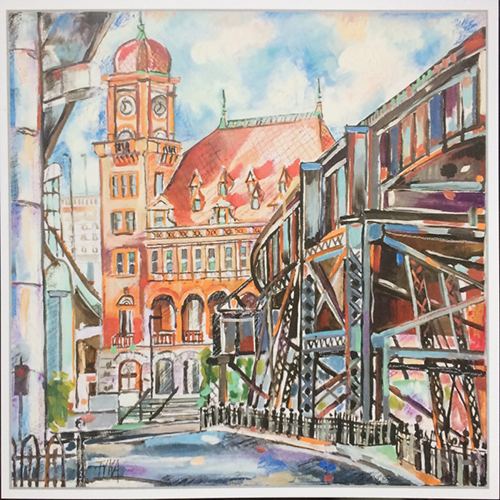
Joanna Tyka: Cityscapes RVA
An exploration of the architecture of Richmond
October 14 - December 31, 2021
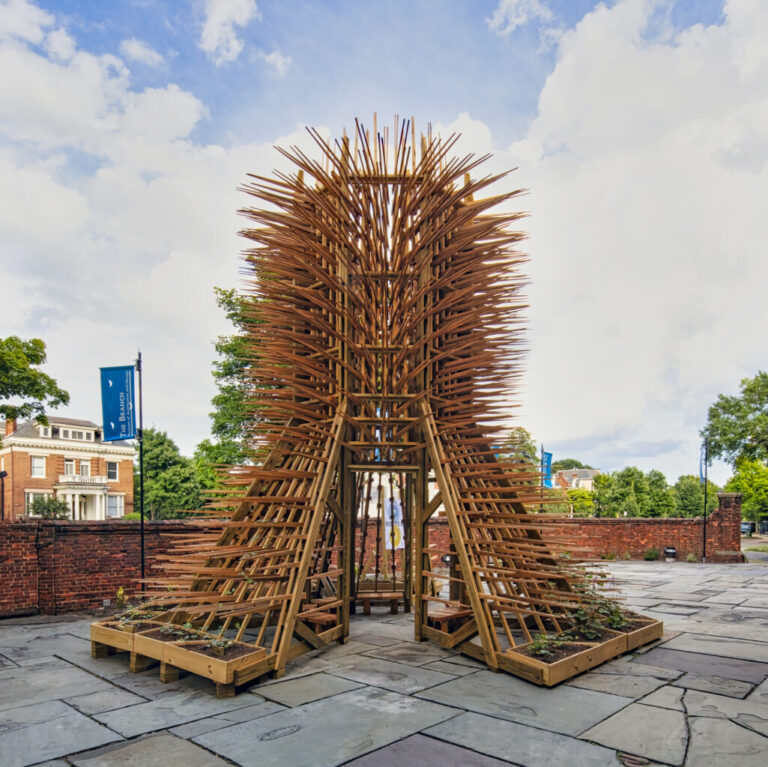
2021 BMAD Design + Build Challenge:
HELPER by An Liu
Highlighting humanity's impact on the natural world
August 2021 - April 2022
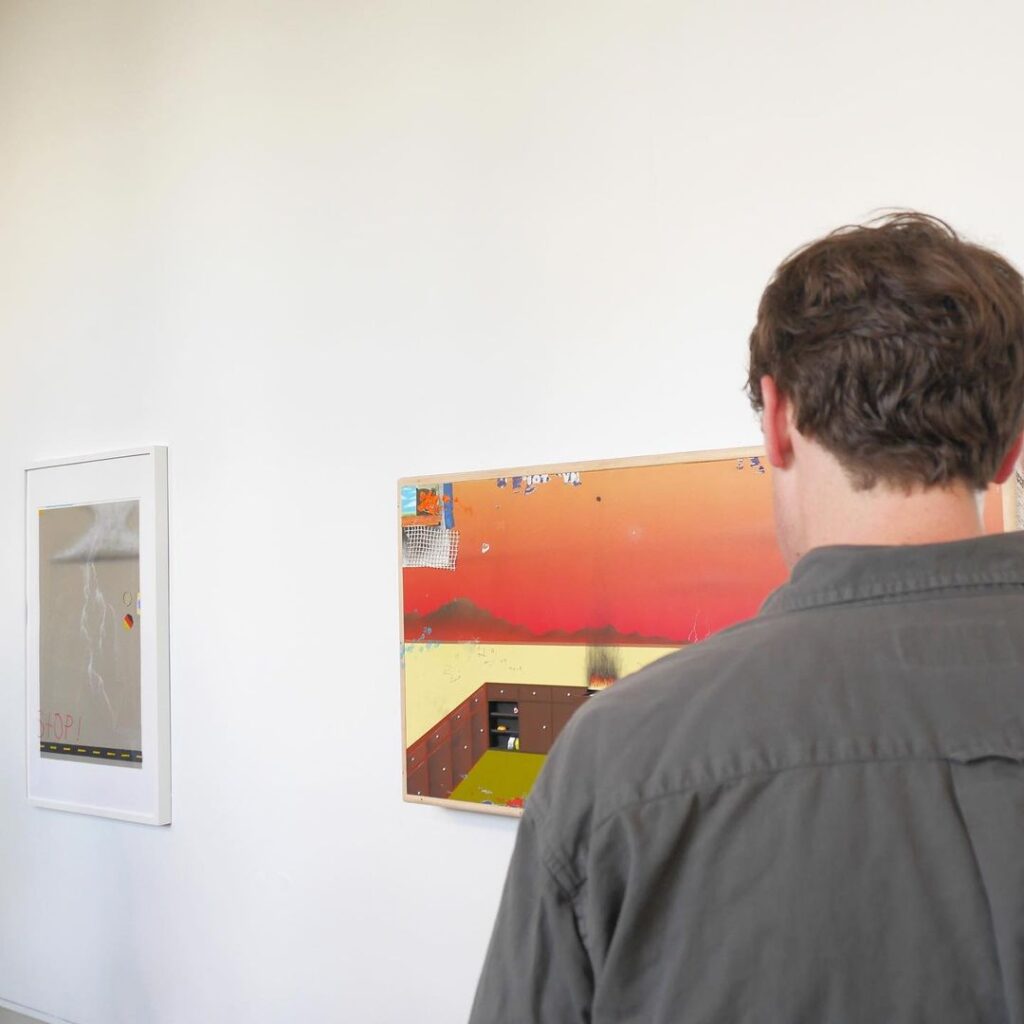
Quality Time
A celebration of the work of ten Virginia Commonwealth University alumni
July 15 - August 28, 2021
2020
Inner Lives:
Cinerary Jars by Julian Stair and Rob Barnard
March 3 - March 27

"Inner Lives" Virtual Experience
With The Branch currently closed for a few weeks, we regretted that closure would limit the number of people who could see this wonderful exhibition of ceramic design. Rob Barnard has found a virtual way to share the exhibition with our guests. We hope you will click on this link and enjoy a few moments of peace, beauty and tranquility exploring ceramic design.
“Inner Lives,” an exhibition by ceramics artists Julian Stair and Rob Barnard, will be on display at the Branch Museum of Architecture and Design from March 3 – 27. Stair and Barnard have achieved international awards and recognition for their pieces that showcase the versatility of the medium while remaining utilitarian in form and function.
Barnard is one of America’s most respected potters with work in public collections including the Museum of Art and Design, New York; Renwick Gallery, Smithsonian; Everson Museum, Syracuse and has received two National Endowment for the Arts awards.. Working out of the Shenandoah Valley, Virginia, for the last 40 years, Barnard has established a reputation as an eloquent advocate of pottery within contemporary art practice through both his artistic output and critical writing for journals such as American Crafts, The New Art Examiner, Studio Potter and Ceramics, Art and Perception.
Stair is one of the leading potters in the UK, training at Camberwell School of Art and the Royal College of Art, London. His work is represented in numerous public collections including the V&A; British Museum; Mashiko Museum of Ceramic Art; Museum Boijmans van Beuningen and Kolumba Museum, Germany. Besides exhibitions, he frequently works to commission, recently completing an altar and font for St Augustine’s Church, London. He is also a ceramic historian and has written for the Courtauld Institute, Yale Center of British Art and Tate Gallery.
Barnard and Stair have known each other for over 30 years, exhibiting together twice before, in London in 1997 and Washington, DC in 2017. With different backgrounds and artistic sensibilities, they nevertheless share a common interest in the multi-faceted language of pottery. For this exhibition of 8 jars from each artist, they are re-interpreting the millennial old tradition of funerary ware as part of their belief that pottery can challenge and mediate the inevitability of death, providing metaphorical and practical containment, and solace for what philosopher Simon Critchley called ‘the last great taboo of modern society’.
“Inner Lives” is a contributing exhibition with the National Council on Education for the Ceramic Arts annual conference in Richmond from March 25-28.
Special thanks to Steven Glass, and Howard Risatti.
Design Build Challenge 2020: Ed Pokoj
June 2020 - January 2021

Ed Pokoj is an artist living in Richmond, Virginia. Ed’s work is often playful and vibrant while exploring different techniques and media ranging from illustrations for children’s literature to larger than life puppets. Ed chose to take on the 2020 BMAD project as an opportunity to work on a larger scale than he had worked than he had worked in before. The design itself, a take on the Trojan Horse, had its own specific points that Ed found particularly interesting: creating a giant sculpture that could move within the space of the Branch Museum courtyard, and to build a horse out of bamboo gathered in Richmond. This task to some may sound like an impossible task, but as Walt Disney once said, “It’s kind of fun to do the impossible.”
Listening Theatres: The Sounds of Iconic Landscapes and Architectural Spaces
July 17 - September 13
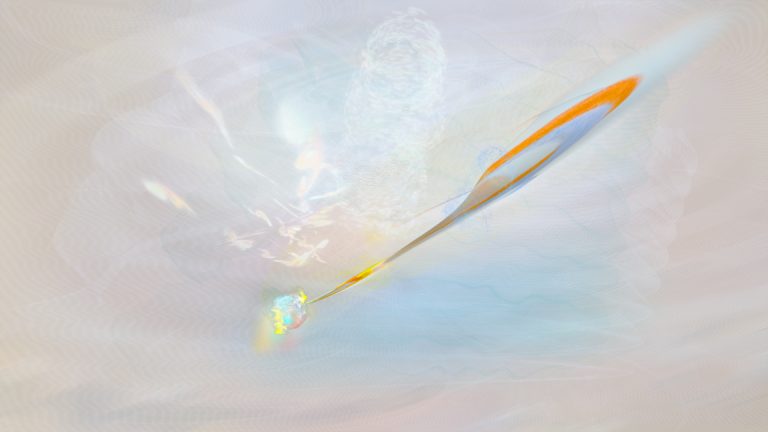
Many architects consider the aural qualities of their created spaces in terms of acoustics. This exhibition explores how listening to these created spaces can inspire creativity, imagination and discovery of the surrounding world. Karen Van Lengen and Jim Welty have created a series of animated soundscapes that portray visual representations of iconic architectural spaces, including The Academical Village at the University of Virginia, and New York City spaces of Grand Central Terminal, The New York Public Library, The Seagram Building, Rockefeller Center and the Guggenheim Museum. Listening Theatres: The Sounds of Iconic Landscapes and Architectural Spaces is an exhibition including sound, animation, and drawings created using real recordings and interpretive drawings, presented in active animations that celebrate the aural personalities of iconic architectures. Photographs of the drawings and stills of the animations are included in a colorful display that demonstrates the artists’ process.
VA Made: Meditation Across Media
July 17 - September 13

VA Made: Meditation Across Media is an exhibition bringing together various artists and various forms of art. At one time, artists were learned in diverse materials and techniques. Today, artists are encouraged to narrow their focus and specialize in a specific art form. VA Made is an exhibition intended to consider the broader view of formats available to the artist. Art forms from large to small, from functional and representational will be exhibited in tandem with one another to explore the relationships between media and subject matter. To this end VA Made is organized around various and diverse things; it features art forms in media that are generally not exhibited together, including pictures, sculptures, jewelry, furniture, and other “functional” objects. In doing so VA Made seeks to call attention to seemingly disparate works of various sizes and made of differing materials–wood, glass, fiber, ceramic, metal, paint–and constructed using a variety of techniques. And while such a presentation of subject matter/material does have the effect of undermining the idea that fine art is somehow superior to craft, the main reason for such a presentation is to encourage broader thinking, especially across media. In this sense, VA Made is an explicit attempt to explore the relationship between media, to wonder about the effect of media on subject matter and subject matter on media, how one informs the other.
Exhibiting Artists
Stephen Addiss | Paolo Arao | Andras Bality | Robert Barnard | Maurice Bonds | Sukjin Choi | David Crane | Barbara Dill | Andrea Donnelly | Ray Edmondson | Joan Elliott | Wayne Fitzgerald | Steven Glass | Jason Hackett | Valerie Hardy | Brooke Hine | Susan Iverson | John Jessiman | Marty Johnson | Cindy Neushwander | Jiwan Joo | Ray Kass | Jim Meyer | Cindy Myron | Kiara Pelissier | Diego Sanchez | Chuck Scalin | Susan Svendsen | Javier Tapia | Lydia Thompson | Adam Welch | Ken Winebrunner | Dale Quarterman
Cub Creek: Twenty Years Together
July 17 - September 13
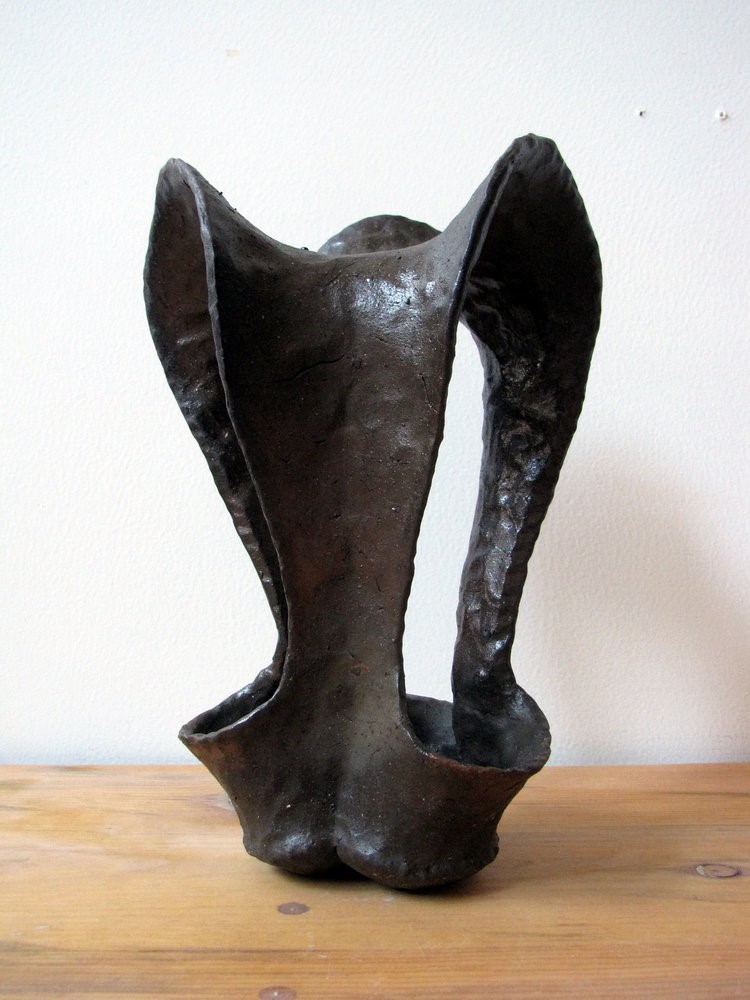
Cub Creek: Twenty Years Together highlights the diverse work of residents and founding members and heighten awareness of the only residency program exclusively for the ceramic arts in the Mid-Atlantic region. The exhibition will be a critical reflection of the abiding respect, affection and enthusiasm for the ceramic arts that is embodied and promoted by the Cub Creek Foundation for the Ceramic Arts. Located in Appomattox, Virginia, Cub Creek hosts workshops and educational events and offers a year-long supportive residency in a rural environment. Cub Creek’s facilities have attracted young ceramic artists from around the world. Several foreign residents have stayed in the Atlantic region and contribute significantly to the vitality of ceramic arts here as teachers and professionals. Workshop presenters at Cub Creek, including Resident Director John Jessiman, represent a virtual who’s who of important figures in the field.
Cub Creek hosts numerous workshops and educational events, and residents prepare and execute regional outreach experiences for local schools and youth groups. In addition, Cub Creek brings internationally recognized artists together annually for a demonstration workshop to share methods and ideas. Regional university students and professional artists are invited to participate.
The Cub Creek Board of Directors believes in providing continued support to those completing a residency. With a network of professional ceramic artists throughout the US and abroad, they have been successful in finding venues for many to continue their educational pursuits.
Exhibiting Artists
Ashwini Bhat | Cory Brown | Sukjin Choi | Brian Pitney | Randy Edmonson | Shanna Fliegel | Steven Glass | Mitch Iburg | Tom Jaszczak | John Jessiman | Heidi Krietchet | Shasta Krueger | Kirke Martin | Brian Pitney | Hitomi Shibata |Takuro Shibata | VanderMey | Vicki Wilson
2019
Laura Heyward
January 14 - February 1
Laura Heyward has been drawing and painting for most of the last 40 years, working in oil, acrylic, pen and ink, printmaking, and collage. Several years ago, she began spending a day or two each month doing pen and ink illustrations of bouquets of flowers and plants from her yard to concentrate on a love of color.Heyward draws inspiration from Arthur Dove, “it is more like poetry or writing which tries to describe through senses and emotion. It is personal.” This sentiment is also expressed through her more playful work — this short exhibit also contains some of her “cigar box creations”.
BridgePark at the Branch
February 1 - March 4
The Branch Museum is pleased to present an exhibition of the exciting BridgePark project. BridgePark is an ambitious vision to create a world-class linear park running through both sides of downtown Richmond and across our beautiful James River, while engaging vital historical and natural sites along the route. The engaging 28-foot long architectural site model will be on display along with beautiful park renderings and exciting images highlighting the park plans.
Monumental Youth

February 16 - April 20
This exhibit collects the designs of Richmond region high school students for the next monument on Monument Avenue. The narratives, sketches, and sculptures shown here address issues of representation in public statuary, heroism, and visions for an Avenue that reflects the values of its youngest community members.
Storefront for Community Design + the mOb Studio have asked Richmond region high school students to design the next monument on Monument Avenue. On display will be models of each students’ monuments, a sketch of their monument, and a short written narrative defending their design choices and figures.
A companion exhibit is on display at The Valentine.
A City Personified: City Historical Maps
April 1 - June 24
Cities are designed, but their ultimate plan can evolve outside of a planned design. We will begin an exploration of urban planning and city design through historic Richmond city maps that illustrate how cities are designed and grow.
Pulling from the archives of the City of Richmond Department of Planning and Review, historical maps will be displayed, showcasing how our city has grown and changed through the decades. From its burning at the end of the Civil War, to turn-of-the-century annexation, to the highway system in the 1950s, to 21st century modernization for the new millennium, the city has continued to change year after year.
Sixty Years of Italian Design 1940-2000
July 11 - Septepmber 15

The Branch Museum of Architecture and Design proudly introduces Sixty Years of Italian Design 1940-2000, an exhibition of iconic contemporary Italian pieces. Maurice Beane, one of the region’s most prominent dealers and collectors, will curate the exhibit and showcase works from his private collection amassed over 40 years. The exhibition opens Thursday, July 11th with a reception from 6-9 p.m. Work will remain on view from July 11 until September 15, 2019.
The 1940-2000 survey presents a wide range of characteristic objects from the 60-year period: furniture, ceramics, Murano glass, works on paper. In addition, selected pieces from the private–and rarely seen–collection of Frances Lewis are among the exhibition highlights. Lewis and her late husband, Sydney, were among the earliest and most discerning collectors of Memphis Milano and Studio Alchimia.
Principal artists on view will include Osvaldo Borsani, Cesar Lacca, Joe Colombo, Ettore Sottsass, Carlo Malnati, and Gaetano Pesce. Other artists represented are: Alessandro Mendini, Fulvio Bianconi, Gio Ponti, Achille Castiglioni, Marcello Fantoni, Guido Gambone, Cesare Lacca, AldoTura, Piero Sartogo, Piero Fornasetti, Ettore Sottsass, Matteo Thun, and Barovier & Toso.
Hiding in Plain Sight: The Architecture of Charles M. Robinson
October 3, 2019 - January 5, 2020
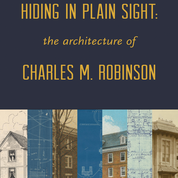
Exploring the life and works of one of Virginia’s most prolific architects. The exhibit will feature architectural renderings, photographs, and ephemera pertaining to the life and works of the architect Charles M. Robinson, whose career spanned from 1889 to 1932.
SPECIAL THANKS TO:
The Branch Exhibitions Committee Chair
Sally Brown
for shepherding this project
and Brenden Bowman, Exhibit Curator
This exhibition and associated events are made possible through the generosity of an anonymous donor.
The Branch Museum gratefully acknowledges permission for use of images, objects, and works on paper from:
Robert A. Boynton, FAIA, Principal of Boynton Rothschild Rowland Architects, PC, Richmond
Michael Farrow and the Blair County Historical Society
Library of Virginia
Simpson Library, University of Mary Washington
Ann Willis Robinson
David Bruce Robinson, CPA
Valentine Museum
Special Collections, Virginia Commonwealth University James Branch Cabell Library
Special Collections Research Center, William & Mary Libraries
Susan Custer Willis
2018
Carlton Abbott: 50 Years of Architectural Drawings
This exhibition displays a remarkable collection of drawings created over Carlton Abbott’s career, celebrating over fifty-years of artistic expression and excellence. Abbott’s career began after he graduated from the University of Virginia and finished his studies at the Ecole des Beaux-Arts, Fontainebleau, France. After this, Abbott went on to become an artist and architect. Though primarily known for his landmark museums and high-profile structures, Abbott is an accomplished artist. Carlton received his first of over eighty design award recognition from the American Institute of Architects in 1968. His artistic talents are as widely renowned as his architecture and are displayed throughout the country in private and public collections as well as in permanent collections at the VMFA and the Virginia MOCA. His artwork is as diversified as his architecture, including drawings, paintings, collages, mixed media, sculptures, etchings, ink sketches, jewelry, and metal works.
This exhibit spans his entire career and celebrates his unique ability to affect his community in a profound way. More specifically, this exhibition holds a notable series of drawings which depict some of the buildings along the Blue Ridge Parkway. These images hold precedence due to Abbott’s father, Stanley Abbott, being the primary designer of the Blue Ridge Parkway.
This exhibition was generously made possible by Carlton Abbott.
Frozen Music: Frank Gehry and the Walt Disney Concert Hall
February 12 - April 14

The Branch Museum’s inaugural exhibit returns to our galleries after fifteen years! On view in our galleries February 12 – April 14 will be over 100 images of the construction of Frank Gehry’s Walt Disney Concert Hall, photographed by Gil Garcetti.
Frank O. Gehry practiced on the fringe of the architectural mainstream before gaining worldwide renown. Early in his career, he worked to develop a personal style through experimentation on his own house and his furniture line of cardboard chairs, and he eventually became a prominent figure in Deconstructivism. The completed Walt Disney Concert Hall has begun to transform Los Angeles, making a “place” in the heart of an urban environment previously lacking in identity. As a work of art, the building’s curved planes of steel create unusual and inviting relationships that change by the hour with the movement of the sun. It is a masterpiece that reinforces Gehry’s reputation as an innovator capable of flexing the boundaries separating architecture from art.
In the summer of 2001, photographer Gil Garcetti drove past the energized construction site of the Walt Disney Concert Hall and was inspired by what he saw: high in the air, crawling precariously on top of an arched beam, was a man in a hard hat. Over a nine-month period, Garcetti developed relationships with the members of the Ironworkers Union Local 433. He moved from one steel beam to another without the benefit of a safety harness to document their exploits on one of the most challenging construction projects at the start of the 20th century.
In early 2003, Gil Garcetti returned to the Walt Disney Concert Hall after an acquaintance introduced him to the Hasselblad X-Pan II panoramic camera, through which he saw unique opportunities to capture the building’s new skin. The magical qualities of the building – its composition, form, shape, and the ever-changing light conditions – seduced Garcetti, who said, “We knew they were building a concert hall – a hall of unusual beauty. What most of us never realized was that they were also building hundreds of works of abstract art.”
Covering: Layered Light, Texture, and Motion
April 10 - May 20

Non-tradition materials contrast with quintessential motifs used for centuries by handicraft artisans. Spirals, whorls, and concentric circles intermingle with chevrons and diamond patterns, covering the surfaces of acrylic, silk georgette and muslin. Sensors and actuators control light and movement while screens distance the viewer form the object, obscuring vision and clarity. Hawa Stwodah is an Afghan born designer and instructor based in the United States. She received her BFA and MFA from Virginia Commonwealth University, her career has spanned many sectors within the fashion industry, including fashion and textile design, product development, technical design and production, as well as retail buying and education.
Rafie Khoshbin: Daughters of Baha
April 16 - 22

Since its establishment, the Islamic Republic of Iran has shown a profound disdain for one of its largest minority faiths and created a nationwide effort to prosecute Baha’is through arrest, fabrication of false crimes and accusations of spying. The year 2018 marks the 35th year anniversary of the execution of these beloved women who fearlessly dedicated their life to advancing the betterment of humanity. Their spirit, their vision, their heart will always be remembered. In the face of tragedy they stood unwavering with love.
VCU MFA Candidacy Work: Graphic Design
April 17 - 27
VCU Masters of Fine Arts first year students from the Graphic Design department will show their work at the Branch.
VCU MFA Candidacy Work: Theater
April 30 - June 10
VCU Masters of Fine Arts first year students from the Theater department will show their work at the Branch.
My Superhero Self: Posters by Girls CAN
April 30 - May 14
Superhero posters were completed by students in the Girls CAN program, run by the Chester Family YMCA in Chester, Virginia. Girls CAN is a girl empowerment group for elementary and middle school girls in Greenleigh Mobile Home Park.
Virginia by Design Awards Exhibit
April 30 - June 10
Join us in celebrating the winning work of the 2018 Virginia By Design Awards! This exhibit, designed by Middle of Broad Studio, will showcase the winning projects and exemplary designers recognized by the inaugural Virginia by Design awards.
Coloratura at 35: A Retrospective
June 22 - August 19

For thirty-five years Catherine Roseberry and Rob Womack, working at Coloratura, have been using furniture as a canvas for a thorough exploration of the arts of the past. The process begins with the selection of a piece of furniture carefully chosen to reflect a given period and design sensibility. After the piece is selected it is studied, with research done on various art or design movements concurrent with the era of each piece. Woven into the surface design of each piece may be inspirations from painting, music, film, literature or applied arts such as furniture, textile, graphic and automobile design; parallels that perhaps may have also inspired the original designer/creator of the piece of furniture. They view their works as art historical musings.
Honored with a National Endowment for the Arts Visual Artists Fellowship (1994), Womack received two similar awards from the Virginia Commission for the Arts (1994 and 1999), as well as residency fellowships to the Virginia Center for Creative Arts (2001, 2002, 2004 and 2007). The two also received a major commission (1995) from the City of Richmond, through its Percent for Art Program, for a new mural for the restored Landmark Theater (since dismantled).
Coloratura has been noted in a variety of periodicals, including the New York Times, the Washington Post, the Chicago Tribune, Metropolis, Metropolitan Home, House Beautiful and Elle Décor. Publications featuring Coloratura range from the photo book Craft in America (1993), to Sotheby’s Important 20th Century Design (2008) to Buie Harwood’s discussion of the work within historical context in Architecture and Interior Design from the 19th Century, Volume 2 (2008).
Womack is represented in the permanent collection of the Renwick Gallery of the Smithsonian American Art Museum, as documented in Oscar Fitzgerald’s catalog Studio Furniture of the Renwick Gallery (2008). He and Roseberry were participants of the International Contemporary Furniture Fair for its first three years (1989-1991), which led to international recognition through numerous publications, such as Ufficio Style, Casa Vogue and the launch issue of the UK Metropolitan Home.
The Coloratura at 35 retrospective will be the largest assembly of works by the couple to date. The exhibition has goals of showing the consistency and broadness of vision as well as rigorous scholarly approach to works ranging from the 1980s to now, as well as presenting many privately commissioned works never before publicly displayed.
About Beulah Gould Branch, Mrs. John Kerr Branch
September 20 - November 2

Information about Mrs. Beulah Branch, her life, and the work done this summer restoring her bedroom will be in the Long Gallery September 20th – November 2nd.
(Im)permanence - Cynthia Myron
September 20 - November 2
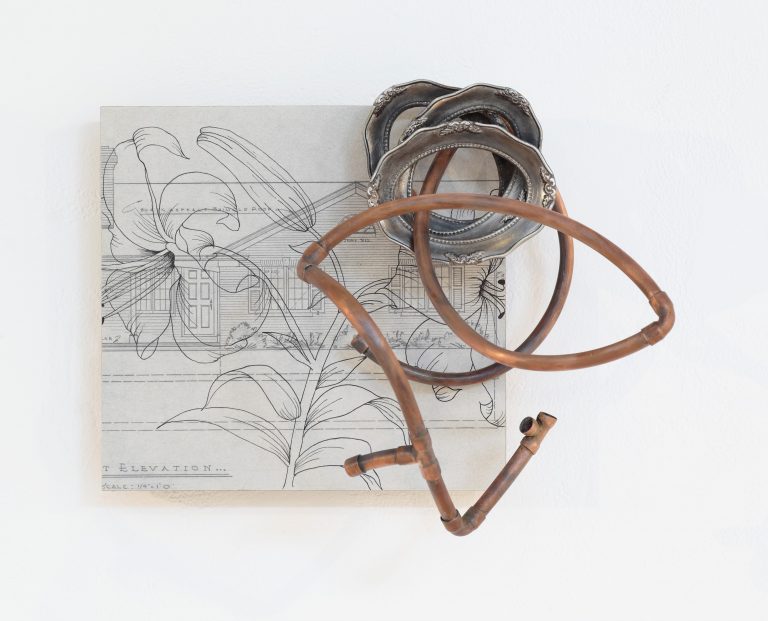
(Im)permanence invites the viewer into a dialogue between society, intimate spaces, and the fleeting moments that exist within nature and the permanence of the architecture that surrounds us. The pieces featured by Cynthia Myron in this exhibition are a culmination of works revealing passing of individual memory, emotional weight, and lasting recollection that exists within constructed spaces.
The work created for (Im)permanence challenges viewers to contemplate the idea of home and how it serves as a symbol of safety and shelter. Myron’s three-dimensional work draws inspiration from symbolism, history, architecture, ideas of value, and man-made alterations to our natural environment. During her time as an artist-in-residence at The Branch Museum this summer, Myron explored layering these themes while embarking on new inspirations including the architecture that surrounded her at The Branch. This uniquely tied in with her archival research that explores the rich 20th Century Tudor-Revival architecture in Northeast Pennsylvania that exploded during height of coal mining. This industry that once shaped the region has helped her formulate ideas surrounding family, community, and socioeconomics, as she spent a significant amount of her life in Northeast Pennsylvania where her family still resides.
Myron’s use of symbols including historically rooted imagery of Faberge, provide commentary to consider the value and preciousness of gold as she replaces it with pewter. This permits a new narrative void of monetary worth in today’s society. Other objects such as anthracite coal when cast in pewter and plated in gold, invite us to deconstruct the notions of labor, industry, and commodity. The ideas and work within (Im)permanence present the opportunity to consider what is constant and reliable compared to what is mutable, shifting, and curiously inconsistent.
For more information please visit Cynthia Myron’s website.
Planar Assemblages: Furniture and Other Works, Sandy Bond
November 8, 2018 - January 20, 2019
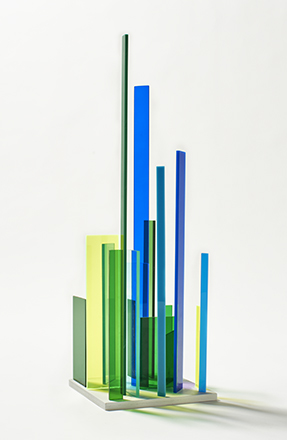
Sculptures, furniture, and other work from the career of Sanford Bond.
My career has focused on creating places by defining space with various materials. Primarily as an architect, I focus on places for human habitation using a palette of different materials to define discreet regions of space accommodating various human endeavors. Every material possesses a unique set of characteristics rendering it different from any other. These innate qualities may be used to generate unique and different places enabling a range of use and meaning differing with the person.
The material of my sculpture is structural steel, a common building materiel that is very hard, heavy, strong and uniquely may be joined by welding producing a joint as strong as the material itself. The long, thin, cantilevered shapes cannot be replicated in wood or concrete. The actual manufacture of steel imparts a unique texture and the rugged visceral feel of the material. Fabrication results in welding beads at the joints acknowledging, at once, the separate pieces and the continuity of material without loss of strength.
The sculpture is spatial exploration done in the abstract rather than focused on particular uses. As analogs to reality, they have no actual scale rather the viewer supplies his own perception of the reality within the piece. By intensifying definition, place is suggested subject to the experience of the viewer. At once they are cities of tall buildings or verdant forests one might wonder through depending on one’s feeling at the time and limited only by the imagination.
As co-founder and principal of 3North Architects, and a practitioner in Richmond for almost half a century, Sanford Bond has shaped some of the city’s most iconic buildings, such as the Richmond Ballet, the American Civil War Museum, and the Maymont Aviary. As both an architect and a sculpture artist, Bond’s career has focused on creating places by defining space with various materials. The materials of his sculptures are common industrial materials: structural steel, glass, wood, plexiglas or concrete. He exploits the unique characteristics of each medium in the work which lends an appropriateness and timeless quality to them. Bond’s sculptures will be on display at the Branch in the late Fall.
Design 2018: A Retrospective of Winning Work
November 15, 2018 - January 13, 2019
See the mid-Atlantic’s finest examples of architecture, interior design, and preservation projects from 2018 in the eleventh annual exhibition featuring AIA Virginia’s award-winning work from the region.
Historic Dome Restoration, United States Capitol, by Hoffman Architects, Inc. Photo by Hoffmann Architects, Inc.
Marsden Williams
November 23 - 25
For a short time only, see Marsden Williams’ work at The Branch Museum! Marsden has been a lifelong painter, and this special holiday exhibit will include work from her entire career, including work for purchase. Marsden describes a sense of “looking out at the world” which inspired her to begin painting. Her paintings are celebrations of color and gesture, and she has become increasingly involved with the “mystical and transcendent power of color.” Her paintings convey this focus and unique visual observation of some of the places she has lived and found inspiration – Richmond, Virginia; Princeton, New Jersey and Woods Hole, Massachusetts. Central subjects in Marsden William’s work include: landscapes, still life arrangements, flowers, portraits, and beloved Borzoi dogs.
2017
The Landscape Architecture Legacy of Dan Wiley
January 19 - March 30
Dan Kiley (1912-2004) was one of the most important and influential modernist landscape architects of the 20th century. During his extensive career, he worked with equally significant architects, including Eero Saarinen, Louis Kahn and I.M. Pei, to create internationally acknowledged design icons. This traveling photographic exhibition and retrospective features forty-five vibrant photographs, which chronicle the current state of 27 of Kiley’s more than 1,000 projects worldwide.
This exhibition was co-curated by Charles A. Birnbaum, Amanda Shull, and Nord Wennerstrom of The Cultural Landscape Foundation.
History Interpreted: Framing the Historical Event
April 7 - 15
VCUarts Graphic Design students explored history and language, using poster art as the means to convey complex ideas. Sophomore students identified an event or issue in history that was relevant to them as an individual and designed posters that conveyed the significance of each event. The project invited students to explore how history is understood and its context through style and aesthetics.
VCUarts Graphic Design Graduate Conadidacy Show
April 21 - May 3
First-year students in the Design, Visual Communications graduate program display work from their first year. Student work is presented to and critiqued by visiting critic Paul Soulellis, a renowned graphic designer, artist, publisher, and teacher, working in New York City and Providence, RI. His writings and work in the field of experimental publishing and network culture are cited in influential scholarly research. He is the founder of Library of the Printed Web, a physical archive devoted to web-to-print artists’ books, zines, and other printout matter.
The National Mall
May 25 - September 3
The National Mall is a landscape symbol of American Democracy. It has gone through constant change, often neglect, but the Mall continues to serves us as a freely accessible landscape and a platform to shape political and social change. This exhibition tells the history of the National Mall, explores its growth and challenges over time, asks us to consider the Mall’s future through innovation design solutions, and explores the past and future roles of the American Institute of Architects in preserving the National Mall.
This exhibition was made possible by the National Mall Coalition.
See also: https://www.nationalmallcoalition.org/
Linda Z. Hang / Way Wza / FIST: ELECTRIC SUTURES ALPHABETICAL
November 30 - December 3
Way Wza is a multidisciplinary designer and artist who works in photography, painting, sculpture, textiles, book design, artists’ books and performance. Weaving distant cultural ingredients, she gathers esoteric patterns from the structures of her research. In composing these tapestries, what emerges is an itinerant discovery of form and dynamism, inherent and persistent in all complexities of matter regardless of the origination. Inspired by the palm gestures of Buddhism as well as ninja finger weaving exercises (or mudras), the identity for FIST (by Dante Carlos) expresses all the different combinations one can create by raising or retracting a finger.
Hang’s projects have exhibited at the Geffen Contemporary at MOCA in Los Angeles (2013–present), MoMA PS1 (2013–present), Tokyo Art Book Fair (2014) and at NADA with Printed Matter, Inc., in New York (2016). Her work is held in private and public collections, including the Carl A. Kroch Library, RMC at Cornell University (NY) and the Marjorie G. and Carl W. Stern Book Arts & Special Collections Center at the San Francisco Public Library (CA). Hang studied at the Art Institute of San Francisco, California, and currently lives and works in New York City.
This short exhibition is generously made possible by the VCU Graphic Design Department.
Glavé & Holmes: 50 Years of Design
November 30 - December 3

This exhibition celebrated the work accomplished by the many architects who have been part of the firm, the people they’ve worked with, and the spirit and ideals that have inspired the firm for half a century.
Over fifty years ago, two young architects tossed a coin to determine in what order they would place their names on their new letterhead: the firm Glavé Newman Architects was born.
James (Jim) Glavé and William (Bill) C. Newman III were joined four years later by William (Pete) Anderson; the breadth of interest in architecture they each brought to the table came to define a practice – one that was always about more than the individual buildings that came from their hands. Their deep sense of responsibility towards excellence in architecture and design would be influential throughout Virginia, particularly here in Richmond.
Many architects have practiced at the firm known today as Glavé & Holmes Architecture, but the initial passion of Glavé, Newman, and Anderson continues to motivate each designer within the firm. The inspiration of the original partners was to elevate the human spirit, which continues to drive Glavé & Holmes Architecture’s work to this day.
This exhibition is second in a series at The Branch Museum highlighting architects who have had long term and sustained influence on architecture throughout Virginia and beyond. The first exhibition was the Carlton Abbott 50 Year Retrospective; the next is AIA Virginia’s 2017 Awards for Excelling in Architecture.
This exhibition was generously made possible by the Glavé & Holmes 50th Anniversary Legacy Project
2016
The Historic American Buildings Survey: Documenting Virginia's Architectural Heritage
February 18 - June 3
Guest Curator Brian Grogan.
From American Indian settlements to the twenty-first century built environment, no other state has contributed to America’s architectural heritage quite like Virginia. It comes as no surprise then that Virginia played a crucial role in the development of the Historic American Buildings Survey (HABS), the nation’s first preservation program, in 1933.
Virginia buildings were among the first to be recorded by HABS, including Mount Vernon, Monticello, and Colonial Williamsburg. Virginia’s comprehensive range of building types, engineering technologies, and landscapes have continued to provide HABS unparalleled opportunities to add to their public collections, now housed in the Library of Congress.
Through this exhibit, visitors will learn about the story of HABS, the significant role Virginia has played in HABS programs, the HABS collections (free and fully accessible to the public), the methods involved in studying and recording historic sites, and recent and ongoing HABS projects located in Virginia.
Exhibition programming includes a curator’s talk, community roundtable discussion with HABS director and staff, HABS walking tour of Monument Ave. and Fan District, and a family day photography program.
Exhibition and programming presented in partnership with HABS and the National Park Service.
Drawing on History: Infill Design Competition
June 9 - September 4
What does it mean to build new within an existing urban neighborhood that has both historic significance and a distance identity? Join The Branch and Historic Richmond for this exhibition to learn more! This engaging exhibition brings together 14 different design approaches, each addressing the challenges of creating a new building on a vacant lot within a historic district. Each design was reviewed by a panel of judges from the Richmond design, architecture, and housing community. With consideration given to issues like historic context, sustainability, affordability, and the neighborhood’s own unique sense of place, this exhibition is the beginning of a dialogue about the modern design process and its relevance to the fabric of historic neighborhoods.
The Jury
The jury was comprised of a group of architects and design professionals who have a variety of experiences with the City of Richmond’s Standards for New Construction, historic preservation, infill construction, academia, and broad artistic design considerations.





#DrawingonHistory
The Branch Museum of Architecture and Design and Historic Richmond thank 3North, Sadler & Whitehead Architects PLC, and Keithfabry for their generous support of this exhibition.
ballet pas de deux: an exhibition of dance and architecture
September 8 - December 23

ballet pas de deux: an exhibition of dance and architecture presents a striking exploration of two primal expressions of human creativity, dance, and architecture. Building off the traditional ballet term pas de deux, meaning a duet by two dancers, this exhibition started with a simple theme—motion. What resulted is a unique juxtaposition between the artistry of ballet and the aesthetics of architecture. Composed of a series of 30 stunning photographs and an installation of video and sound, ballet pas de deux showcases two of Richmond Ballet’s prominent stars, Valerie Tellmann-Henning and Kirk Henning, dancing through the historic halls of the Branch House.
#balletpasdedeux
The Branch Museum of Architecture and Design would like to thank Richmond Ballet for their support of this exhibition along with these sponsors:
East Made Event Company | Love by Serena Photography | Josh Gooden Cinema | Adorn Company | Alexandra Grecco Bridal | Amanda Burnette Floral Design | BRIDEface Richmond | Elizabeth Dye Bridal | Event Hair by Lauren | MOSAIC Catering + Events | Paisley & Jade | Poppy & Scooter | Sweet Fix RVA | Trumpet & Horn
2016 Awards for Excellence in Architecture: An Exhibition of Winning Work
November 10 - January 1, 2017
“We love to share the best of the best,” says The Branch Museum Director Dr. Craig Reynolds. “Virginia-based architects and designers never cease to produce exceptional and creative work designed to improve our lives and better our communities.”
The Awards for Excellence in Architecture are given each year by the American Institute of Architects Virginia to recognize projects no older than seven years that contribute to the built environment as clear examples of thoughtful, engaging design. This year juries reviewed nearly 150 entries in categories of Architecture, Residential Design, Contextual Design, Historic Preservation and Interior Design. The 19 projects receiving top awards are featured in the exhibition.
View the award winning projects.
The Branch would like to thank Keith Fabry and Pace Collaborative for support of this exhibition.





